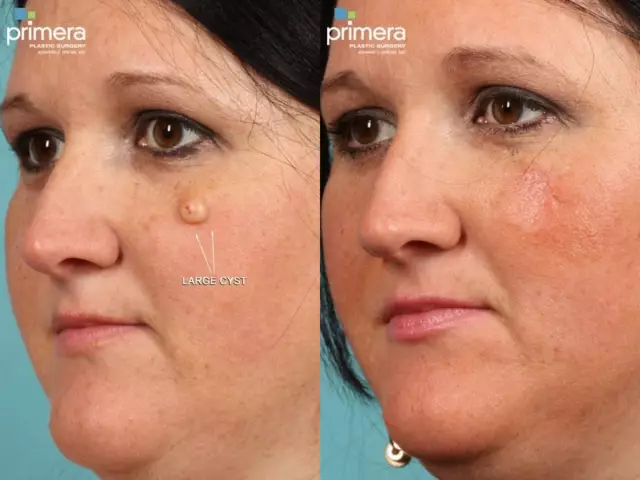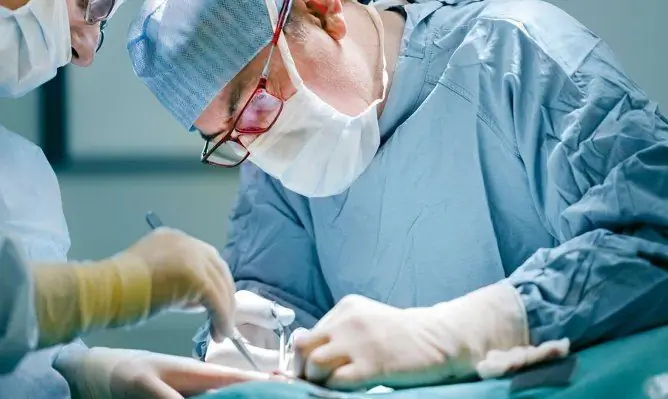- Author Rachel Wainwright [email protected].
- Public 2023-12-15 07:39.
- Last modified 2025-11-02 20:14.
Vaginal cyst
The content of the article:
-
What is a vaginal cyst
Histological structure
- Causes
- Symptoms
- Diagnostics
-
Vaginal cyst treatment
Vaginal cyst: surgery
- Traditional methods of treatment
- Prevention
- Video
Vaginal cyst is a tumor-like retention formation located on the vaginal wall, the increase in which is associated with the accumulation of fluid, and not proliferative growth. According to ICD 10, the disease belongs to group No. 89 (non-inflammatory diseases of the vagina).

The vaginal cyst is round or ovoid and can reach the size of a chicken egg
What is a vaginal cyst
The neoplasm can be located both superficially and penetrate into the thickness of tissues, reaching the paravaginal tissue. Its size usually does not exceed a walnut, but sometimes it can grow to the size of a large chicken egg. The consistency is tight or soft elastic. On examination or in the photo, it can be seen that the cystic formation looks rounded, has an ovoid or round shape.
Histological structure
The outer walls of the vaginal cyst are formed by connective tissue with the inclusion of single muscle fibers. The internal cavity is lined with cubic, prismatic or columnar epithelium. The content is transparent, serous or mucous, the color is from light yellow to dark brown.
Causes
Vaginal cystic formations, depending on the mechanism of their occurrence, are divided into congenital (formed from the remnants of the embryonic ducts) and acquired (traumatic, implantation). Their differences are presented in the table:
| Type of neoplasm | Localization |
| Congenital | Formed from gartner ducts, paraurethral or Müllerian ducts. The latter can be located at the entrance to the vagina (cyst of the vestibule of the vagina) and be combined with malformations. Cystic formations of gartner's passages are usually localized at the level of the fornices and can reach the parametric tissue |
| Acquired | They develop as a result of damage to the walls of the vagina (birth trauma, scraping of the uterine cavity, surgical treatment of vaginal fistulas) and epithelial cells entering the wound. Mostly located in the lower parts of the vagina along the back wall |
Symptoms
In most cases, vaginal cystic formations do not manifest themselves clinically and are detected by a gynecologist by chance when examining a woman for any other reason (medical examination, pregnancy, inflammatory process).
With their significant size, patients may experience the following complaints:
- sensation of a foreign body in the vagina;
- discomfort during intercourse:
- disorders of urination and defecation.
If the integrity of the integument of the vaginal cyst is violated, its contents can fester, which is accompanied by the appearance of signs of colpitis, pathological leucorrhoea and increased pain.
Diagnostics
When performing a gynecological examination with the help of mirrors, vaginal cysts are clearly visible. They look like oblong or rounded formations, soft or elastic in consistency.
Differential diagnosis is carried out with the following diseases:
- diverticula of the urethra;
- rectocele;
- cystocele;
- prolapse of the walls of the vagina.
If necessary, the gynecologist can refer the patient for consultation to doctors of another specialization (proctologist, urologist).
If removal of the cystic formation is indicated, then a preoperative examination is performed, which includes:
- ultrasound procedure;
- microscopic and bacteriological examination of smears of discharge from the vagina, cervical canal and urethra;
- colposcopy.
Vaginal cyst treatment
Dynamic observation is carried out only for small cystic formations that do not cause discomfort to the patient. In all other cases, surgical treatment is indicated.
Vaginal cyst: surgery
Currently, the following types of surgical interventions are performed to remove cystic formations of the vagina:
- Puncture aspiration. In compliance with the rules of asepsis and antiseptics, the doctor punctures the cyst and aspirates its contents with a syringe. It is rarely used, usually in pregnant women with huge formations. This is due to the fact that the effect of puncture aspiration is unstable. Due to the fact that the patient retains a cystic cavity lined with epithelial cells, after a while a relapse of the disease occurs.
- Marsupialization. This method of treatment is the most gentle and safe. The surgeon dissects the cystic mass and empties its cavity, and then sutures its walls to the vaginal mucosa.
- Radical removal of the vaginal cyst. The gynecologist cuts the wall of the formation with a longitudinal incision and exfoliates it in a sharp and blunt way. After that, he sutures the bed and the mucous membrane with catgut.
- Laparotomy. In some cases, it is impossible to remove vaginal cysts emanating from the gartner's passages by means of a transvaginal approach. This is due to the fact that these formations with their upper pole are located deep in the tissue surrounding the pelvic organs, and during their hulling there is a high risk of damage to the rectum and bladder. To prevent such iatrogenic injuries, an abdominal operation with access through the anterior abdominal wall is indicated.
Traditional methods of treatment
Traditional medicine advises many different methods of treating vaginal cystic formations. Most of them are based on the use of herbs that have anti-inflammatory and antiseptic properties. But none of these methods is effective, since the pathological mechanism of the formation of a vaginal cyst is not based on an inflammatory process, but on mechanical damage to the vaginal mucosa or some violations of embryogenesis.
Advice on independent attempts to squeeze out the contents of the cyst by squeezing it is also quite dangerous. Yes, the walls can really burst and the liquid contents will pour out into the lumen of the vagina. But after a while, the disease will relapse, since the cause of its occurrence will not be eliminated. In addition, with this method of self-medication, there is a high risk of infection of the cystic cavity with its subsequent suppuration.
Prevention
To prevent the formation of congenital vaginal cysts in an expectant daughter, a pregnant woman should avoid exposure to factors that have a negative impact on the formation of fetal tissues and organs. These factors include:
- alcohol;
- drugs;
- smoking;
- ionizing radiation;
- some medications.
Prevention of the occurrence of traumatic cystic formations consists in careful delivery and careful performance of any vaginal manipulations in order to prevent damage to the mucous membrane.
Video
We offer for viewing a video on the topic of the article.

Elena Minkina Doctor anesthesiologist-resuscitator About the author
Education: graduated from the Tashkent State Medical Institute, specializing in general medicine in 1991. Repeatedly passed refresher courses.
Work experience: anesthesiologist-resuscitator of the city maternity complex, resuscitator of the hemodialysis department.
The information is generalized and provided for informational purposes only. At the first sign of illness, see your doctor. Self-medication is hazardous to health!






